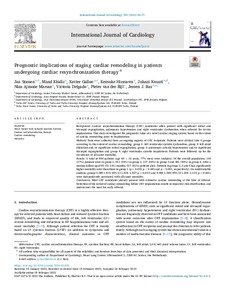Prognostic implications of staging cardiac remodeling in patients undergoing cardiac resynchronization therapy
Stassen Jan; Khidir Mand; Galloo Xavier; Hirasawa Kensuke; Knuuti Juhani; Marsan Nina Ajmone; Delgado Victoria; van der Bijl Pieter; Bax Jeroen J
https://urn.fi/URN:NBN:fi-fe2022081154818
Tiivistelmä
Background
Cardiac resynchronization therapy (CRT) candidates often present with significant mitral and tricuspid regurgitation, pulmonary hypertension and right ventricular dysfunction when referred for device implantation. This study investigated the prognostic value of a novel cardiac staging system, based on the extent of cardiac remodeling prior to implantation.
Methods
Data were collected from an ongoing registry of CRT recipients. Patients were divided into 4 groups according to the extent of cardiac remodeling: group 1: left ventricular systolic dysfunction, group 2: left atrial dilatation and/or significant mitral regurgitation, group 3: pulmonary arterial hypertension and/or significant tricuspid regurgitation and group 4: right ventricular systolic impairment. Patients were followed up for the occurrence of all-cause mortality.
Results
A total of 844 patients (age 65 ± 10 years, 77% men) were included. Of the overall population, 145 (17%) patients were in group 1, 161 (19%) in group 2, 157 (19%) in group 3 and 381 (45%) in group 4. After a median follow-up of 95 (51–145) months, 517 (61%) patients died. Patients in groups 2, 3 and 4 had significantly higher mortality rates than those in group 1 (p = 0.025, p < 0.001 and p < 0.001, respectively). On multivariable analysis, groups 3 (HR 1.415; 95% CI 1.024–1.957; p = 0.032) and 4 (HR 1.599; 95% CI 1.204–2.123; p = 0.001) were independently associated with all-cause mortality.
Conclusions
Most CRT candidates already present with extensive cardiac remodeling at the time of referral. Detection of the extent of cardiac remodeling before CRT implantation results in improved risk-stratification, and underscores the need for early referral.
Kokoelmat
- Rinnakkaistallenteet [27094]
